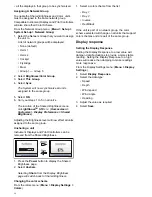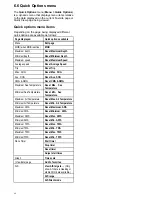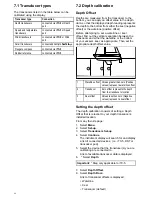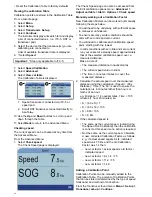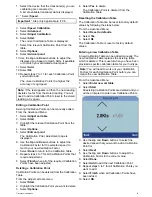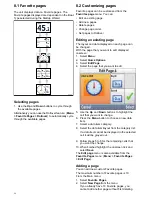
9. Select the location that you want depth
measurements to be taken from.
After selection the Depth Offset page is displayed.
If you have selected Waterline or Keel a Depth
Offset must be applied.
10. Select
Offset:
.
11. Use the
Up
and
Down
buttons to adjust the
Depth Offset to the required value.
The offset value should be the same as the
measured distance:
• from the transducer face to the Waterline, or
• from the transducer face to the bottom of the
Keel.
12. Select
Save
.
Setting an incorrect Depth Offset could lead to your
vessel running aground.
7.3 Speed calibration
Speed transducer calibration is required as
transducer performance is affected by a number of
variables such as transducer location, shape of the
hull and water flow characteristics. The purpose
of performing Speed calibration is to ensure that
the speed readings at the instrument are a true
indication of the vessel’s actual speed.
In order to achieve accurate results, speed
calibration must be carried out in calm conditions
with zero tide and zero current.
Speed calibration aligns the instruments log speed
(Speed Through Water) to:
• Speed Over Ground (SOG), or
• a referenced speed
Calibrating using SOG
For most installations a 1 Point Speed Calibration is
all that is required.
If the 1 point calibration does not provide sufficiently
accurate readings or you require a higher level of
precision for your speed readings then a Speed Run
Calibration can be carried out. It is advisable to carry
out the Speed Run Calibration at as many speeds as
possible. This is particularly important for planing
vessels.
* Conventional speed transducers have a maximum
of 5 calibration speeds, and smart transducers (e.g.
DST800) have up to 8.
If required each calibration point can also have a
calibration factor applied to further align the log
speed reading across different vessel speeds.
Note:
* The Speed Run Calibration cannot be
performed when the transducer is connected to
a Speed Pod.
Calibrating without SOG
For most installations a 1 Point Speed Calibration
is all that is required. The calibration must be
performed using a way of estimating actual vessel
speed and adjusting the displayed reading so that
the log speed matches the your estimated speed.
If you do not have SOG data available then the
Speed Run Calibration cannot be performed.
If required, further calibration points can be added
and a calibration factor can be applied to further
align the log speed with actual vessel speed.
iTC-5
Smart (DST)
Speed pod
SOG
No
SOG
SOG
No
SOG
SOG
No
SOG
1 point
speed
calibration
Speed run
calibration
Manual
calibration
Transducer calibration
43










